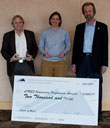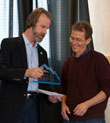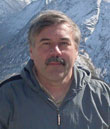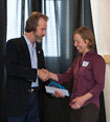|
Performance Awards
Performance Awards Home
Nomination Criteria and Tips
Make a nomination
Contact us via email
Recipients
2014 |
2013 |
2012 |
2011 |
2010 |
2009 |
2008 |
2007 |
2006 |
2005 |
2004 |
1999 - 2003
|
Science and Engineering Awards
 Sonja Wolter, Doug Guenther, and Dr. Fred Moore – ESRL/GMD Sonja Wolter, Doug Guenther, and Dr. Fred Moore – ESRL/GMD
In early 2008, Associate Scientists Sonja Wolter and Doug Guenther and Research Scientist Fred Moore took on the challenge of upgrading existing Programmable Flask sampling Packages (PFPs) in order to meet stringent FAA flammability requirements for on-board instrumentation. This upgrade was not required to maintain the existing sampling program, but was instead an effort to substantially broaden the scientific capabilities of the atmospheric CO2 and trace gas sampling program at NOAA/CIRES. Meeting FAA requirements, while maintaining the expected mechanical reliability of existing PFPs, proved to be a daunting task. More than half the elastomeric parts of the existing PFPs needed to be replaced, and the repeated failures of candidate materials in flame and/or mechanical stress tests made the path to success less than certain. Even after acceptable materials were found, integrating the new PFPs onto the space and weight-constrained aircraft platform in a way that did not affect existing instrumentation demanded highly creative solutions. The skill, resourcefulness, hard work, and just plain persistence of this exceptional team resulted in a successful deployment of the newly designed PFP onboard the National Science Foundation’s High-performance Instrumented Airborne Platform for Environmental Research (HIAPER) in January 2009. This was only the first of five planned deployments that constitute the HIAPER Pole-to-Pole Observations mission, or HIPPO, but if the exciting early results are any indication, the new FAA-approved PFP design has already proven its scientific worth, and only promises to further advance the cutting-edge atmospheric and climate-related research taking place at NOAA/CIRES, and their partner institutions.
 John Holloway – ERSL/CSD John Holloway – ERSL/CSD
John Holloway is a CIRES Associate Scientist working in the Earth System Research Laboratory’s Chemical Science Division. He was nominated for a CIRES Outstanding Performance Award in Science and Engineering for performance far above his academic credentials and contributions that exceed the expectations of his position. John, on his own initiative, developed an instrument using vacuum UV florescence to measure CO from an aircraft. The instrument performs as well or better than any other in the world, and has attracted international attention. John also volunteered to undertake the engineering challenge of deploying the VUV-CO instrument within an under-the-wing pod on the NOAAWP- 3D. This successful pod deployment created space for increasing the measurement capacity aboard the aircraft. John’s effort demonstrates his initiative and willingness to accept a challenge. He shows commitment to his work and team by repackaging and relocating his instrument to make way for other measurements. John serves as a principal investigator for two instruments during WP-3D field campaigns. He takes responsibility for the operation and repair of the VUV-CO instrument, in addition to making a sulfur dioxide measurement. He manages data reduction, analysis, and the archiving of the final data sets. He has logged 13 WP-3D campaigns in this capacity, functioning clearly above the expectations of a Professional Research Associate. Although John is first author on three publications, he has accumulated a record of 83 papers in which he is a co-author. His inclusion as a coauthor on so many publications speaks to the critical role that the data sets play in contributing to science, as well as to John’s leadership and collaborative engagement.
 Sergey Matrosov – ESRL/PSD Sergey Matrosov – ESRL/PSD
Sergey Matrosov is a CIRES Senior Research Scientist with the Water Cycle Branch at ESRL/PSD (Physical Sciences Division). He has made outstanding contributions to scientific research on determining the properties of clouds and precipitation from millimeter wavelength radar. Over the last 19 years since he arrived in the United States, he has prolifically developed simple and elegant retrieval techniques that have formed the basis for an observational capability leading to an understanding of cloud microphysics and precipitation which have supported studies of climate, radiation balances, weather modification, hydrological cycles, and flood warning systems. In addition to creating a body of theoretical discipline, he has also supported his work with validation studies (comparing retrieved results to aircraft in-situ sampling) and inter-comparison studies (between different retrieval techniques and sensors) showing an ability to move the theory into the practical regime of application. He has served (and is serving) as a science team member for the CloudSat program, the Department of Energy Atmospheric Radiation Measurement Program and is recognized nationally and internationally. Besides his outstanding contributions in research, he also contributes to educational mentoring and advising as an adjunct faculty member at Colorado State University. He has also contributed significantly to the development of a cooperative program between NOAA and the Russian Federal Service for Hydrometeorological and Environmental Monitoring to develop a new International Observatory in Siberia.
Service Awards
 Adriana Raudzens Bailey –CIRES Administration Adriana Raudzens Bailey –CIRES Administration
Science writer Adriana Raudzens-Bailey very eagerly and efficiently fulfills her regular CIRES duties, which in 2008 included constructing press releases for dozens of CIRES fellows and scientists, as well as facilitating several high-profile press conferences. However, one story illustrating how she so typically exceeds all requirements and expectations involves the transformation of a simple press release for David Noone into a story that was pitched to various news agencies, leading to an article in The Christian Science Monitor, and an editorial feature in Nature. She also facilitated a live radio interview, set up a real-time “notes from the field” blog on the CIRES website, and most recently, contributed an NSF “Discoveries” feature describing the atmospheric water vapor research of Dr. Noone and colleagues. Other examples of Adriana’s initiative and creativity include developing an ocean current exhibit for the Smithsonian, designing a web-based blog to track the (mostly) scientific exploits of CIRES scientist Ludovic Bariteau as he cruised the Southern Ocean as part of the Gas Exchange (GasEx) experiment, and producing a terrific, if somewhat disturbing, video on coastal erosion in Alaska that was featured on Andy Revkin’s “DotEarth”, a popular New York Times blog on science and the environment. Adriana regularly demonstrates an uncanny ability get the right stories told to the right audiences via the right channels, without diluting the fundamental science that is so cherished by the scientists of CIRES.
 Molly Heller – ESRL/GMD Molly Heller – ESRL/GMD
Molly Heller came to CIRES in 2005 to work with NOAA's Global Monitoring Division's Carbon Cycle Greenhouse Gases group. Molly is wholly responsible for ensuring that a worldwide network of nearly 100 sampling sites is kept supplied with the necessary equipment to conduct weekly and bi-weekly sampling, the "bread and butter" of the CCGG group's research, as well as conducting quality testing and preparation of all the surface network sample containers destined for use in the field. She streamlined and improved the processes in her lab so effectively that, even though this role was once shared between two people, Molly is now able to complete this critical work on her own. She has also tested, prepared, and shipped hundreds of sample containers to China as they initiated additional sampling procedures into their own atmospheric monitoring program. Finally, Molly manages to find time in her full schedule to participate directly in fieldwork herself, traveling to a variety of locations to help set up new sampling sites, and train sample collectors. All this goes to show that Molly is an exceptional CIRES employee, fulfilling her regular responsibilities in an effective and efficient manner, as well as taking those additional steps that do so much to make the jobs of everyone she works around easier. This alone might have justified her nomination for the CIRES Outstanding Performance in Service Award, but in 2008 Molly took on a role completely unrelated to her regular "day job", and spearheaded an effort to implement composting and significantly expand the recycling at NOAA's David Skaggs Research Center, cutting trash production by half, or over 150 tons per year! This has been, and will continue to be for years to come, an incredible service to her CCGG coworkers, all her colleagues in the DSRC, and indeed the entire Boulder community.
|